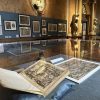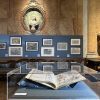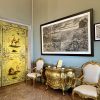Rinascimento in bianco e nero
L’arte dell’incisione a Venezia 1494-1615
From 8 March to 3 June, 2024
Venice, Ca’ Rezzonico – Museo del Settecento Veneziano
Curated by Giovanni Maria Fara and David Landau
With the support of Save Venice
In conjunction with Museo Civico of Bassano del Grappa
![]()
During the Renaissance, Venice established itself as the leading Italian centre for the production and distribution of prints through its position as an international emporium open to the major trade routes. As the fulcrum of a veritable revolution in images, the city was the market for some of the 16th century’s most important and fascinating graphic works and publications.
The Fondazione Musei Civici di Venezia, in conjunction with the Museo Civico of Bassano del Grappa, is devoting a major project to this unique artistic season, retracing the supreme achievements of graphic art in the Serenissima, fully comparable with painting, as if one were the mirror of the other.
The core of the project is the collections of the two institutions, partly restored thanks to support from Save Venice. Ensuring a complete overview of this extraordinary artistic phenomenon, they are supplemented with works from private and public collections: the Biblioteca Nazionale Marciana, Fondazione Giorgio Cini, Accademia di Belle Arti of Venice, Scuola Grande di San Marco, Biblioteca del Museo Correr, as well as the Biblioteca Queriniana of Brescia, Biblioteca Palatina of Parma, and the Gabinetto dei Disegni e delle Stampe of the Gallerie degli Uffizi.
The project, which will run concurrently in the two venues and be accompanied by a single catalogue, is divided into chronological and thematic sections: innovations in the late 15th century; large formats; Venetian and foreign printmakers in the first and second decades of the 16th century; the creation of chiaroscuro; “By Titian […] many landscapes”; men of letters and printers in the mid-16th century; “through prints, the manners of Italy” in Venice; “Titianus inventor”: the workshop and graphics from maturity to the master’s late period; Agostino Carracci, engraver after Veronese and Tintoretto; Giuseppe Scolari “excellent designer and engraver”.
These are accompanied by some further insights, especially devised for specific sections of the exhibition present only in Venice or Bassano, to mark the originality of the itineraries and the extraordinary richness of the individual collections. The themes addressed are of exceptional significance and present some of the greatest artists of the time: Andrea Mantegna, Albrecht Dürer, Jacopo de’ Barbari, Titian and the workshops of his innumerable engravers, Tintoretto, Veronese, Benedetto Montagna, Ugo da Carpi, Domenico Campagnola, Agostino Carracci and Giuseppe Scolari.
A layout with a great visual impact comprising over a hundred works for each venue, in which the “felicitous black lines” of engravings, so highly praised by the humanists (as Erasmus of Rotterdam wrote, who coined this expression in comparing Dürer’s many-sided graphic output with the renowned but lost paintings of Apelles) are measured against the foundational themes, universally recognized, of Venetian art: tonal chiaroscuro, landscape, canvases, narrative painting, the female nude, the dialectical relationship with different artistic traditions, a personal idea of antiquity and the defence of its own irreducible identity.
Through prints – multipliable and easily transportable, without geographical or linguistic boundaries – Venice revealed what it most intimately meant for the artistic tradition of Europe: an essential crossroads of experiences in continuous and tumultuous innovation.
Admission to the exhibition with the Museum’s hours and ticket.





